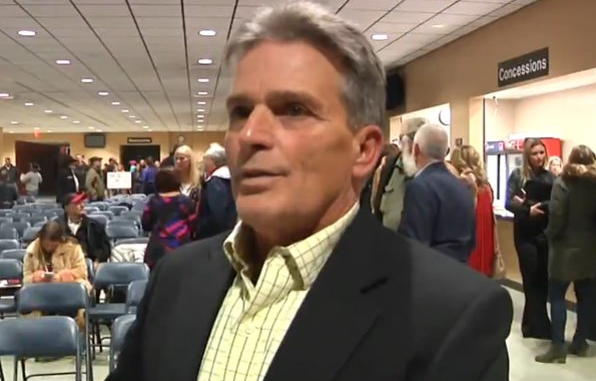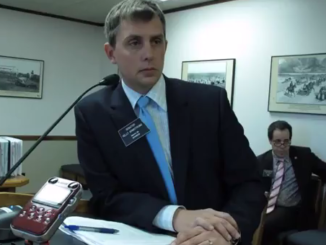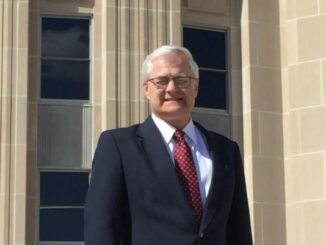
It was long known that if Republican State Senator Kelly Armstrong of District 36 was successful in his bid to replace Congressman Kevin Cramer in the U.S. House that he would need to resign his seat as a state lawmaker. So, when Armstrong clobbered Mac Schneider (D) and Charles Tuttle (I) on November 6th with over 60% of the vote, it became a matter of formality that he would do so.
There are multiple reports in relation to Armstrong’s resignation. Valley News Live reported that the resignation took place on November 7th— the day following the general election. Other news outlets — like this one from KFYR — simply use Armstrong’s media release to report his resignation on November 8th.
Then there’s this report from the Dickinson Press that also says the resignation took place November 8th, and correctly cites the fact that District 36 must make the appointment to replace him within 21 days of Legislative Management notifying them of the vacancy.
But the number of days in which district party’s are required to appoint replacements for vacancies in the Legislative Assembly isn’t the only aspect mandated by law. Section 16.1-13-10 of the North Dakota Century Code is explicit in how appointments are to be made.
For our purposes here, I’m going to break the law down into the steps that are to take place following a vacancy in the North Dakota Legislature:
- County Auditor Notifies Chairman of Legislative Management – “If a vacancy in the office of a member of the legislative assembly occurs, the county auditor of the county in which the former member resides or resided shall notify the chairman of the legislative management of the vacancy.” (Note: The process is different for circumstances under Section 44-02-02, but that doesn’t apply here.)
- Chairman of Legislative Management Notifies District Committee – “Upon receiving notification of a vacancy, the chairman of the legislative management shall notify the district committee of the political party that the former member represented in the district in which the vacancy exists.”
- District Committee Holds Meeting and Fills the Vacancy within 21 Days – “The district committee shall hold a meeting within twenty-one days after receiving the notification and select an individual to fill the vacancy.” We’ll talk more about this in a moment, but this is where District 36 may have messed up.
- Conditional Step of Legislative Management Making the Appointment – “If the former member was elected as an independent candidate or if the district committee does not make an appointment within twenty-one days after receiving the notice from the chairman of the legislative management, the chairman of the legislative management shall appoint a resident of the district to fill the vacancy.” Again, we’ll talk more about this in a moment, but these terms and verbiage are very important to understanding #3.
- Secretary of State Notified of Appointment – “The secretary of state must be notified of an appointment made by a district committee or the chairman of the legislative management according to this section. Upon notification, the secretary of state shall issue the appointee a certificate of appointment and an oath of office for the appointee to complete and file with the secretary of state.”
In order to understand the law, it’s important that we understand what is meant by “District Committee”. According to the North Dakota Republican Party bylaws, it is as follows:
“The Republican Precinct Committeemen elected or appointed as provided by law together with the Republican nominees for, and the members of the Legislative Assembly and the officers of the District Committee shall constitute the District Committee of the Republican Party within each legislative district.”
Who then are the officers of the District Committee? Again, according to the NDGOP bylaws:
“The officers of the District Committee shall be a Chairman, one or more Vice Chairmen, a Secretary, and a Treasurer.”
So, to review, the District Committee is comprised of:
- Republican Precinct Committeemen
- Republican Nominees for the Legislative Assembly (When Applicable)
- Members of the Legislative Assembly
- Chairman
- Vice Chairmen
- Secretary
- Treasurer
Now that we understand who comprises the District Committee, let’s consider the law as outlined above.
As you can clearly see, the District Committee is required to make an appointment within 21 days of notification of the vacancy. In this situation, the 21-day rule is not in question. But the law clearly illustrates that it is the District Committee who holds a meeting and makes the appointment. This is clearly indicated when the law says:
“… if the district committee does not make an appointment within twenty-one days after receiving the notice from the chairman of the legislative management, the chairman of the legislative management shall appoint a resident of the district to fill the vacancy.” (Emphasis Added)
This aspect of the law was recently carried out in District 4. It was there that the embattled Rep. Bill Oliver (R) cited personal reasons and resigned from his seat in the U.S. House. We confirmed with District 4 Republican Chairman Charles Walen that the District Committee there convened a meeting and themselves voted to appoint Clayton Fegley to replace Oliver— not attendees at a convention.
But when District 36 convened their meeting on November 30th, it appears it wasn’t the District Committee doing the appointing at all. They literally held a convention-style meeting. There were four candidates vying for Armstrong’s seat and when all was said and done, we received this message:
“Elkin won in District 36 on the first ballot with 56% of the vote.”
This is in reference to Jay Elkin, who has been serving as a Stark County commissioner. One news report summed it up that “the people of District 36 decided who they wanted to take Kelly Armstrong’s vacated seat in the state senate.” Technically, not even this is accurate. Only Republicans had a say in the meeting. But I digress.
The point is that it doesn’t appear that the District Committee was making the decision— the people attending were. Even the video in the article seems to confirm this. And prior to the meeting — that even the District 36 Republican Facebook page calls a convention — District Chairman John Enderle told the Dickinson Press that, “It’s going to be by a vote of the entire membership.”
Now, let me be clear. I’m not suggesting that the people of District 36 shouldn’t get to determine who the appointee is to replace Kelly Armstrong. What I’m pointing out is that it appears the law wasn’t followed in doing it. In fact, there’s a separate process laid out in state law to do just that. It’s found in Section 2 of the aforementioned law.
- Qualified Electors Can Petition for a Special Election – “The qualified electors of a legislative district in which a vacancy in the legislative assembly occurs may petition for a special election to be called by the governor to fill the vacancy.”
- Petitions Must Include Signatures of 4% of the Population of the District – “The petition must include the signatures of qualified electors equal in number to four percent of the resident population of the legislative district as determined by the last federal decennial census…”
- Signatures Turned in to Secretary of State – “… and must be presented to the secretary of state within thirty days following an appointment being made according to subsection 1.”
- Secretary of State Verifies the Signatures – “If the secretary of state determines the petition contains the required number of signatures of qualified electors of the affected legislative district, the secretary of state shall notify the governor that a special election is required to be called to fill the vacancy.”
- Governor Directs Special Election to be Held – “Upon receiving such notice, the governor shall issue a writ of election directed to the county auditor of each affected county commanding the county auditor to hold a special election to fill the vacancy at a time designated by the governor.”
- Special Election Conforms to Applicable Deadlines – “A special election under this section must conform to the applicable election deadlines found in this title and may be called to coincide with a regularly scheduled primary or general election provided the special election is called by the fifteenth day before the deadline for candidates to file for office before a regularly scheduled primary or general election.”
- Special Election Prohibited Between General Election and 80 Days Following Legislative Session – “A special election under this section may not be scheduled to occur during the time from a general election through eighty days following the adjournment of the next ensuing regular session of the legislative assembly.”
As you can see, this is clearly the process that is to be used if “qualified electors” are not satisfied with the appointment made by the District Committee. It’s literally a check on the power of the committee— that can be used by qualified electors regardless of party affiliation.
To further illustrate this point, that the District Committee is to make the appointment, the Century Code specifies when party’s can hold conventions as part of the process. This is found in Section 16.1-13-14:
“If a special election is called to fill a vacancy in any office for which a party nomination may be made, the proper party committee shall call a convention to make a party nomination for such office, and the precinct committeemen of the district must be duly convened and shall elect the required number of delegates to such convention. Individual nominations for special elections must be made in accordance with the provisions of chapter 16.1-12.”
Do you see the difference? There is absolutely nothing in Section 16.1-13-10 that authorizes a party to convene a convention to determine the appointee for a vacancy in the Legislative Assembly. The convention process is specifically reserved in law for the event of a special election.
Now, could have the District 36 Committee permitted those attending the meeting to vote as a means of straw polling who they wanted to replace Kelly Armstrong? And then voted as a committee to honor the wishes of the attendees? I suppose it could be argued that such a move would be a workaround of the law. But it doesn’t appear that this is what has happened. From all the reports I’m getting, they ran this like a convention, and that is not what state law requires.
To clear all of this up, we are seeking the following answers:
- Did the District Committee in District 36 use the votes of attendees as a straw poll and then vote as a committee to officially determine the appointment?
- Or did the District Committee run the meeting like a convention and let the attendees determine the appointment without a vote of the committee?
If the answer to these questions show that the vote was nothing more than a straw poll and the District Committee followed with their official vote, then it’s likely that no violation took place. But if the District Committee didn’t officially vote themselves to appoint Jay Elkin, then that would be a violation of the law and Legislative Management would now be required to make an appointment.
It’s awfully difficult to get answers to these questions on a weekend. And I suspect that even if a violation did occur, that nothing will be done about it or Legislative Management would likely just appoint Elkin themselves tomorrow— a move that I certainly wouldn’t argue with. After all, new legislators are set to take the oath of office tomorrow and the District Committee seemed committed to honoring the wishes of the majority of attendees at the meeting.
But beyond all of this, do these circumstances bring to light a needed reform in the way appointments to fill vacancies are done? Should a District Committee alone be able to determine who in their party is appointed? Or should the law be amended to permit party members in the district to make that determination?
If it’s found that the District Committee failed to follow state law, I think Mr. Elkin should still receive the appointment to replace Kelly Armstrong from Legislative Management. All indications are that the majority of Republican party faithful in District 36 want that. But I also think that this law needs to be looked at in the upcoming 2019 Legislative Session. The questions arising in the aftermath of Friday’s District 36 meeting/convention are evidence of that.
Note: We have reached out to District 36 Chairman John Enderle and will update the article if he responds.
Sources:
- https://results.sos.nd.gov/ResultsSW.aspx?text=All&type=SW&map=CTY
- https://www.valleynewslive.com/content/news/Kelly-Armstrong-Resigns-from-North-Dakota-Senate-Seat–500067501.html
- https://www.kfyrtv.com/content/news/You-Election-Leader-Kelly-Armstrong-resigns-ND-Senate-seat-500074022.html
- https://www.legis.nd.gov/cencode/t16-1c13.pdf#nameddest=16p1-13-01
- https://www.legis.nd.gov/cencode/t44c02.pdf#nameddest=44-02-02
- https://ndgop.org/executive-committee/#1535732366160-54913d04-fcf1
- https://www.sayanythingblog.com/entry/western-north-dakota-lawmaker-with-a-job-in-minnesota-will-resign-his-seat/
- http://jamestownsun.com/news/government-and-politics/4536925-new-north-dakota-legislators-take-office-monday
- https://www.myndnow.com/news/bismarck-news/elkin-to-fill-vacted-distrcit-36-senate-seat/1631396274
- https://www.facebook.com/ND-District-36-GOP-1446487255656164/?ref=bookmarks
- http://www.thedickinsonpress.com/news/4535523-vacated-senate-seat-grabs-friday?fbclid=IwAR3dx_k4fYDVCEvN0U5JPG2t_Ang0rcsLI21rBn6LVXb3baoHJ5pPcwgK9k





